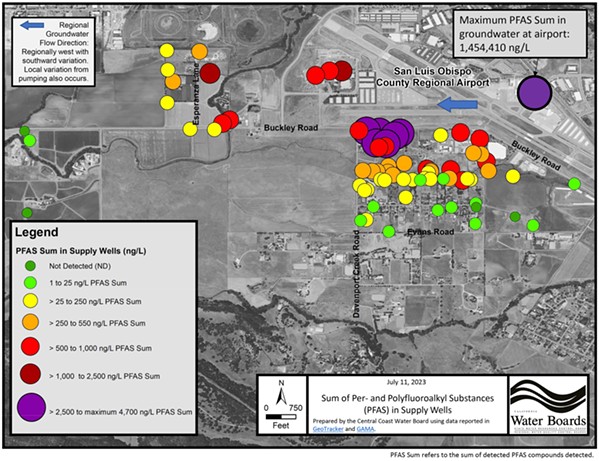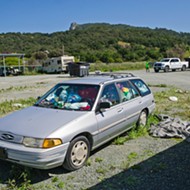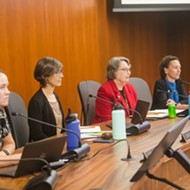[{
"name": "Newsletter Promo",
"id": "NewsletterPromo",
"class": "inlineCenter",
"insertPoint": "4",
"component": "15264767",
"requiredCountToDisplay": "0"
},{
"name": "Ad - Medium Rectangle CC01 - 300x250",
"id": "AdMediumRectangleCC01300x250",
"class": "inlineCenter",
"insertPoint": "8",
"component": "2963441",
"requiredCountToDisplay": "12"
},{
"name": "Ad - Medium Rectangle LC01 - 300x250",
"id": "AdMediumRectangleCC01300x250",
"class": "inlineCenter",
"insertPoint": "18",
"component": "2963441",
"requiredCountToDisplay": "22"
},{
"name": "Ad - Medium Rectangle LC09 - 300x250",
"id": "AdMediumRectangleLC09300x250",
"class": "inlineCenter",
"insertPoint": "28",
"component": "3252660",
"requiredCountToDisplay": "32"
}]
Cleaning up the toxic "forever" chemicals at and around the San Luis Obispo airport will likely take decades, but a recently ratified voluntary agreement aims to ensure that impacted area residents will at least have clean water to drink before the end of August.
"We're going to be watching them, that's all I can tell you," Buckley Road resident Kathy Borland told New Times. "At least we finally have the clock ticking. ... We've been in a holding pattern for the last two years, and we are on the edge of this."
Borland attended the July 21 Central Coast Regional Water Quality Board meeting where its members unanimously agreed to a cleanup and abatement settlement with Cal Fire and San Luis Obispo County, including the SLO County Regional Airport. Her property is one of the "purple circles," aka one of the most impacted properties in the area, which are denoted in purple on an infographic map illustrating the extent of the pollution.
Borland, co-founder of Preserve the SLO Life—which aims to keep residents informed about situations such as this one—said that while residents have reservations about the future, they "feel pretty good" about the next steps.
Since the State Water Resources Control Board directed 29 airports in California to start testing for PFAS (per- and polyfluoroalkyl substances) in 2019, SLO County has tested the soil, groundwater, and residential wells at and near the airport. State regulators say that the pollution stems from firefighter trainings held annually at the airport since the mid-1970s, where a PFAS-rich substance called aqueous film forming foam was discharged into the environment. When ingested at high levels, PFAS is believed to increase the risk of certain cancers, birth defects, and other health issues.
Greg Bishop, who's part of the regional water board's cleanup team, told board members on July 21 that PFAS have a carbon-fluoride bond, which is one of the strongest bonds in chemistry. This means that the collection of substances don't break down and will exist in the environment forever, he said.
Of the 74 water wells tested so far, 57 are polluted with levels that exceed recommended drinking water standards. One well on Buckley tested for PFAS up to 70 times higher than those recommended levels, Bishop said.
"We have a good sense of where we think most of the PFAS are," he said. "We're not done investigating."
As part of the voluntary agreement, Cal Fire and the county agreed to continue testing residential wells for a general investigation into the extent of the pollution with a report due to the water board in 18 months and updates every 60 days. The parties will also conduct a human health assessment, complete an action plan for cleaning up contaminated soil and water, and further develop a public participation plan.
SLO Airport Director Courtney Johnson told the water board that the airport was planning to spearhead something similar to a community advisory committee. She called the agreement a "significant milestone" for everyone involved.
"The collaboration between the water board and the airport parties demonstrates the power of a collective action in securing a cleaner, safer, and more sustainable future for the impacted community," she said. "We're going to do much more than is mandated. We're going to go above an beyond."
The three-year contract aims to eventually give residents with polluted wells "full replacement water," which will be accomplished by either hooking residents up to an already existing municipal water supply, such as the city of San Luis Obispo's, or by installing a wellhead treatment system on each of the affected wells. Borland said the treatment systems would likely cost between $10,000 and $30,000 apiece, depending on the size of the well and property's water use.
Within 30 days of July 21, the parties must ensure that impacted properties have clean drinking water—a point-of-use system—through something like reverse-osmosis filtration installed at the kitchen sink. And by the end of the year, the parties are expected to have installed some sort of filtration system (either a carbon filter or ion exchange system) on the water supply going into the homes—known as a point-of-entry system.
Although most impacted residents already have point-of-use or point-of-entry systems, the majority of property owners paid for the installation. Regional water board chair Jane Gray asked whether the county and Cal Fire would agree to reimburse that cost. Johnson said the parties could discuss the potential of doing something like that and report back on the conclusion of that conversation, but wouldn't agree to doing much more than that.
Water board member Stephanie Harlan said she wished the length of the agreement was longer and that the timelines to provide replacement water were shortened. However, she added that she understood the intent was to renegotiate the terms of agreement at the three-year mark.
"I'm somewhat reassured that this is not going to go away at the end of three years or four years, that we will continue the hard work," Harlan said. "I'm glad we've been able to establish some trust. ... I wish we could do more." Δ
Latest in News
Readers also liked…
-

Coast Unified teachers upset over new position's salary and qualifications
Oct 20, 2022 -

SLO police identify alleged driver who hit and killed couple
Dec 22, 2022 -

When the levee breaks: Oceano residents, county officials walk a tightrope of regulations to manage Arroyo Grande Creek, which some say led to the levee's failure in January
May 18, 2023








